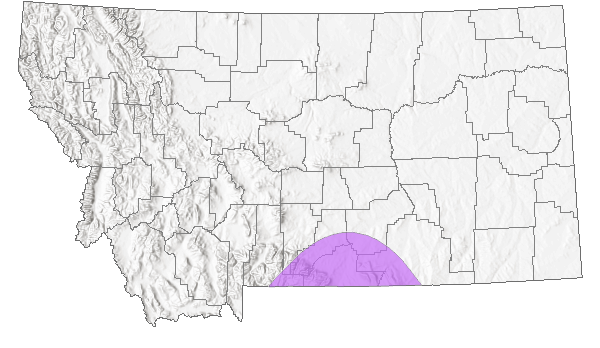View in other NatureServe Network Field Guides
NatureServe
Montana
Utah
Wyoming
Idaho
Wisconsin
British Columbia
South Carolina
Yukon
California
New York
Wyoming Toothpick Grasshopper - Paropomala wyomingensis
General Description
The following is taken from Helfer (1971), Otte (1981), Capinera and Sechrist (1982), Richman et al. (1993), Capinera et al. (2004), and Brust et al. (2008). This long, slender bodied grasshopper is variable in body color, which can be light green, light brown, pinkish or yellowish and tends to be uniform in the individual. The face is strongly slanted, with a pale stripe extending from below the eyes, across the ventral lateral lobe of the pronotum (thorax). The eyes are oblong, and the antennae are sword-shaped (ensiform) and close to the eyes. The tegmina (forewings) are pointed and shortened, reaching only to the 5th abdominal segment. In males the hind femur extends to last abdominal segment, in females nearly to the tip of the of the forewings. The hind tibia can be a dull green or blueish with black spines.
Phenology
This species overwinters in the egg stage. Nymphs occur in spring and early summer (dates not reported). Adults occur from July to October (Otte 1981, Capinera and Sechrist 1982, Capinera et al. 2004, and Brust et al. 2008).
Diagnostic Characteristics
The following comes from Helfer (1971), Otte (1981), Capinera and Sechrist (1982), Richman et al. (1993), Capinera et al. (2004), and Brust et al. (2008). The body length for males is 19-31 mm, and 25-40 mm for females. The male subgenital plate is long and pointed.
The Wyoming Toothpick Grasshopper could be confused with the only other toothpick grasshopper occurring in Montana,
Short-winged Toothpick Grasshopper (
Pseudopomala brachyptera).
Species Range
Montana Range
Range Descriptions

 Native
Native
Range Comments
From the north, in southern Montana, and southwest South Dakota, to central Mexico. From west to east in southern California, southwest Nevada, across the Rocky Mountain States and southwest to west Texas, and the western half of Oklahoma, Kansas, and Nebraska. In Montana, it was reported in 2017 in Carbon County (Otte 1981, Capinera et al. 2004, C.P. Gillette Museum of Arthropod Diversity 2018).
Habitat
This species inhabits low, moist to wet areas in grasslands and prairies with small to medium grass clumps. It clings to grass stems and difficult to flush. During disturbance, it makes short flights and seeks cover in other grass clumps. However, it is often reluctant to jump and often freezes when approached (Otte 1981, Capinera et al. 2004, and Brust et al. 2008).
Food Habits
Consumes almost exclusively grasses such as:
Western Wheatgrass (
Elymus smithii), bluegrasses (
Poa sp.),
Needle-and-Thread (
Stipa comata),
Blue gramma (
Bouteloua gracilis),
Sand Dropseed (
Sporobolus cryptandrus),
Purple Three-awn Grass (
Aristida purpurea),
Long-stolon Sedge (
Carex inops),
Indian Ricegrass (
Oryzopsis hymenoides),
Big Bluestem (
Andropogon gerardii) and
Little Bluestem (
Schizachyrium scoparium). It has been reported to feed on milkvetches (
Astragalus sp.) (Otte 1981, Capinera and Sechrist 1982, Capinera et al. 2004, and Brust et al. 2008).
Reproductive Characteristics
Nymphs pass through 5 instars before reaching the adult stage. Courtship, mating, and egg laying habits are unknown (Capinera and Sechrist 1982).
Stewardship Responsibility
References
- Literature Cited AboveLegend:
 View Online Publication
View Online Publication Brust, M.L, W.W. Hoback, and R.J. Wright. 2008. The Grasshoppers of Nebraska. Lincoln, NB: University of Nebraska Extension Service, APHIS.
Brust, M.L, W.W. Hoback, and R.J. Wright. 2008. The Grasshoppers of Nebraska. Lincoln, NB: University of Nebraska Extension Service, APHIS. C.P. Gillette Museum of Arthropod Diversity. 2018. https://agsci.colostate.edu/agbio/gillette-museum/
C.P. Gillette Museum of Arthropod Diversity. 2018. https://agsci.colostate.edu/agbio/gillette-museum/ Capinera, J.L. and T.S. Sechrist. 1982. Grasshoppers of Colorado: Identification, Biology, and Management. Fort Collins, CO: Colorado State University Experiment Station, Bulletin 584S. 161 p.
Capinera, J.L. and T.S. Sechrist. 1982. Grasshoppers of Colorado: Identification, Biology, and Management. Fort Collins, CO: Colorado State University Experiment Station, Bulletin 584S. 161 p. Capinera, J.L., R.D. Scott, and T.J. Walker. 2004. Field Guide to Grasshoppers, Katydids, and Crickets of the United States. Ithaca, NY. Cornell University Press.
Capinera, J.L., R.D. Scott, and T.J. Walker. 2004. Field Guide to Grasshoppers, Katydids, and Crickets of the United States. Ithaca, NY. Cornell University Press. Helfer, J.R. 1971. How to Know the Grasshoppers, Crickets, Cockroaches, and Their Allies. Revised edition (out of print), Mineola, NY: Dover Publications.
Helfer, J.R. 1971. How to Know the Grasshoppers, Crickets, Cockroaches, and Their Allies. Revised edition (out of print), Mineola, NY: Dover Publications. Otte, Daniel. 1981. The North American Grasshoppers. Volume 1. Acrididae (Gomphocerinae and Acridinae). Harvard University Press. 275 pp.
Otte, Daniel. 1981. The North American Grasshoppers. Volume 1. Acrididae (Gomphocerinae and Acridinae). Harvard University Press. 275 pp. Richman, D.B., D.C. Lightfoot, C.A. Sutherland, and D.J. Ferguson. 1993. A manual of the grasshoppers of New Mexico. Las Cruces, NM: Cooperative Extension Service, Handbook No. 7.
Richman, D.B., D.C. Lightfoot, C.A. Sutherland, and D.J. Ferguson. 1993. A manual of the grasshoppers of New Mexico. Las Cruces, NM: Cooperative Extension Service, Handbook No. 7.
- Web Search Engines for Articles on "Wyoming Toothpick Grasshopper"
- Additional Sources of Information Related to "Insects"





